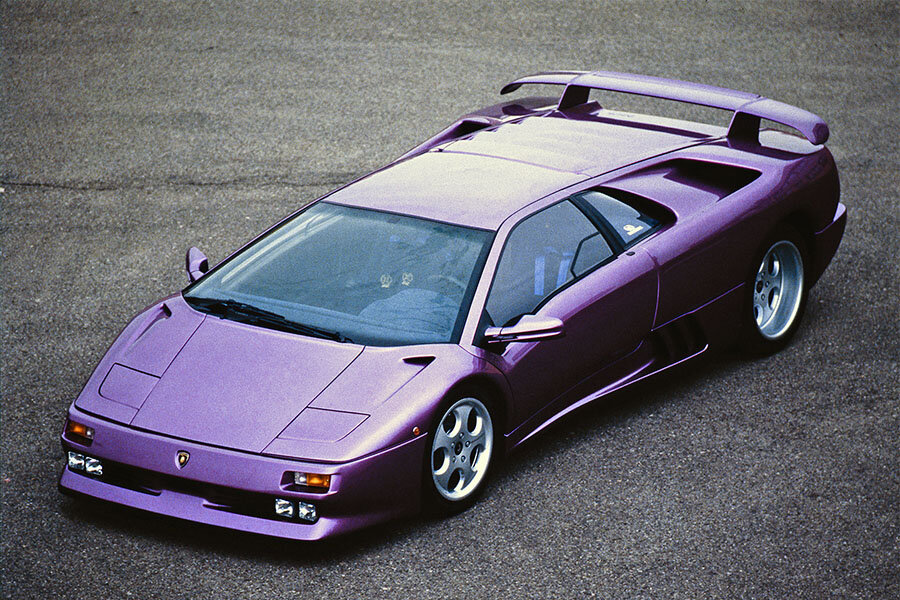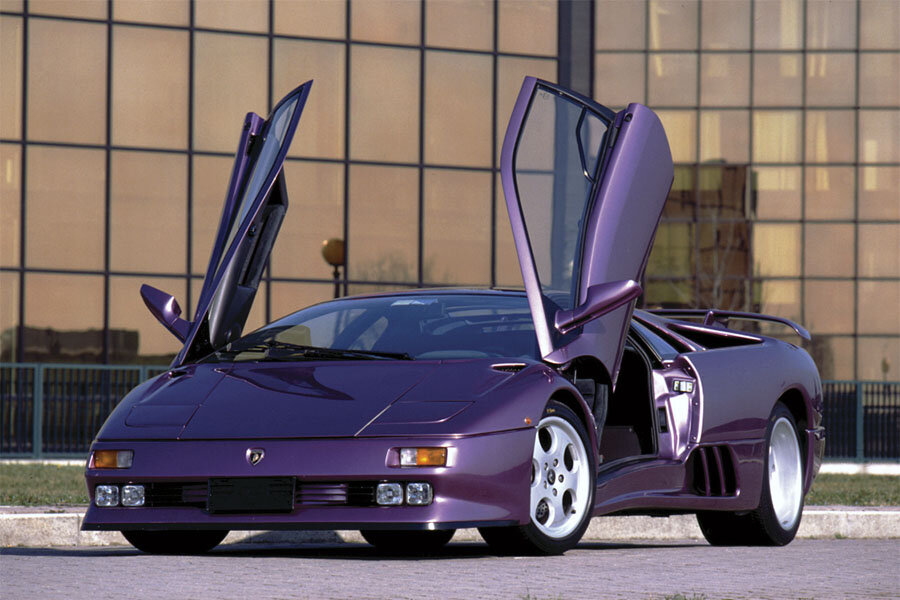Guide: Lambo Purified - a Historical & Technical Appraisal of the Lamborghini Diablo SE30
/BACKGROUND
When the Countach 25th Anniversary was launched in 1988, it replaced the outgoing Countach Quattrovalvole as a permanent fixture in Lamborghini’s model line up.
During the red hot collector car boom of the late 1980s, the 25th Anniversary quickly became the best-selling Countach ever.
Although the economic conditions were very different as Automobili Lamborghini’s 30th anniversary approached, the opportunity was taken to introduce a celebratory variant of the by now three-year old rear-wheel drive Diablo.
The resultant Diablo SE30 was unveiled at Sant’Agata in September 1993 during the third annual Lamborghini Day celebration which had attracted over 150 owners and their cars from around the world.
When the SE30 concept was conceived in early 1993, GT racing was starting to undergo an exciting revival. After years of domination by Group C Prototypes, sports car racing had imploded; privateer drivers turned to a new breed of more cost-effective production-based cars.
With homologation requirements slashed to historic lows (just a single road-going version of the proposed racing variant), it was fairly inexpensive for manufacturers to supply suitable mildly tuned cars. As a result, the likes of Porsche, Ferrari, Lotus, McLaren, Marcos, Venturi, Morgan and many more ultimately got in on the action.
With this in mind, the SE30 was much more than a typical special edition that had been dressed up with some optional extras thrown in. Rather, the new variant was significantly lighter, sharper, more powerful and faster than the donor car upon which it was based.
The optional Jota kit offered to SE30 customers would form the basis for a proposed GT1 racing variant. For those buyers that wanted to go racing (or just have the most extreme specification available), Lamborghini also offered a roll cage. A built-in fire-suppression system and four-point safety harnesses would be standard equipment on the entire production run.
The SE30 was limited to a run of 150 specially numbered vehicles. It was offered in both left and right-hand drive from the outset.
Once the order book was full, production got underway. The first SE30s began to roll out of the factory in June 1994.
ENGINE / TRANSMISSION
Engine modifications included installation of re-programmed LIE digital multi-point fuel-injection and a free-flow sports exhaust.
The SE30 engine was also little lighter on account of its modified cylinder heads and intake manifolds (both of which were fashioned from magnesium).
A 10.0:1 compression ratio was retained.
Likewise, displacement stayed at 5709cc thanks to a bore and stroke of 87mm and 80mm respectively.
Peak output went from 492bhp to 525bhp at an unchanged 7000rpm.
The torque rating was again 428lb-ft at 5200rpm
The Diablo engine was the latest incarnation of Lamborghini’s Giotto Bizzarrini-designed 60° dual overhead camshaft V12. It ushered in a new dry-sump lubrication system and three-way catalytic converters. Notably, it was 542cc bigger than the outgoing Countach engine. Four valves were employed per cylinder. The block and heads were normally formed in lightweight aluminium alloys.
Transmission was via a five-speed gearbox with new ratios, a dry single-plate clutch, a ZF final drive and limited-slip differential.
CHASSIS
Under the skin, the SE30 was based on the rear-wheel drive Diablo platform . This meant it did without four-wheel drive, electronic Koni dampers and power steering (as fitted to the VT). At this stage, Diablos did not come with ABS brakes.
On the SE30, the brake discs were cross-drilled as well as ventilated.
A kind of traction control system enabled drivers to select the most suitable drive setting for the conditions.
Handsome new single-piece OZ Racing magnesium wheels were the same width as before (8.5-inches front and 13-inches rear. However, the rear wheels were enlarged to an 18-inch diameter. The fronts stayed at a 17-inch diameter.
Another special SE30 feature was an automatic fire extinguishing system. It was plumbed into the engine bay and could be operated via a dash-mounted switch.
Otherwise, the specification was pure Diablo.
The chassis comprised a square-tubed steel spaceframe reinforced around the cockpit with carbonfibre inserts and high strength alloys. The wheelbase measured 2670mm.
Suspension was via independent double wishbones with single coil sprung dampers at the front and two dampers per side at the back. Anti-roll bars were fitted at either end. The front axle also incorporated anti-dive electronics.
Ventilated brake discs and calipers were supplied by Brembo. 330mm diameter discs with four-piston calipers were installed at the front. The back end ran the larger 310mm discs (introduced for 1994) with twin piston calipers.
Pirelli P Zero tyres were fitted.
A single 100-litre fuel tank was located on the right-hand side of the engine bay up against the rear bulkhead.
BODYWORK
Externally, the SE30 was equipped with new bumper assemblies, re-profiled side intakes and a Miura-style slatted engine cover. Cooling was improved all round and a new rear spoiler was created specially for this application.
The bumpers, side skirts, front lid and engine cover were all fabricated from carbonfibre.
The new front bumper had the Diablo’s four rectangular spot lights now pushed out to the corners. Inboard of them on each side was a large slatted intake duct for the brakes. The Lamborghini badge normally found on the front lid was moved to the face of the bumper.
Enlarged and restyled scoops ahead of the rear wheels were fitted with two vertical body coloured intake slats instead of the three black horizontal slats used on other Diablos.
The single-piece glass windows normally used by Lamborghini were another casualty of the weight reduction programme. Each was replaced with a two-piece assembly that comprised a large fixed piece of light weight synthetic glass and a smaller corner window that was retractable.
Behind the cockpit was a custom engine cover that was re-profiled to incorporate body coloured Miura-style slats.
On the right-hand side rear fender, a flush external filler cap was fitted instead of the usual concealed arrangement.
The new lightweight rear wing was supplied as standard. It featured drooped corners and an adjustable Gurney flap.
At the back of the car, the cooling grille between the tail lights was opened up to allow more hot air to escape. The fog and reverse lights normally housed on this grille were now integrated to the subtly redesigned rear bumper.
Instead of the normal Diablo script found on the grille, the SE30 came with a Lamborghini and 30th Anniversary chrome badges.
Viola was the default paint selection unless the customer specified otherwise.
INTERIOR
Like Viola outside, the default interior was blue suede alcantara.
Suede alcantara was used to cover all the surfaces that would normally have been upholstered in leather. This included the dash, seats, headliner, cockpit pillars, sun visors and rear bulkhead. Even the centre of the special flat-bottomed steering wheel was trimmed with alcantara.
Darker blue/purple carpet covered the floors.
The SE30 door panels and transmission tunnel were new. Both were a mix of bare carbonfibre weave and alcantara. The small opening side windows were operated by a large rotating knob mid way along the upper door band. The roll bar settings could be adjusted from the cockpit by a switch on the centre console.
Seats were new single-piece carbonfibre buckets and the headrests were embossed with a Lamborghini badge. Plumbing for four-point harnesses was standard. Most customers opted for conventional seatbelts as a no-cost option.
To save weight, the air-conditioning and audio system were left absent. Aluminium pedals were drilled for lightness.
The dash was the svelte new variant that had initially been brought in with the Diablo VT. For the SE30, white-faced dials replaced the black-faced gauges normally seen in the Diablo. Large analogue read outs for road and engine speed were flanked by smaller gauges for oil pressure, oil temperature, water temperature and fuel.
In a nod to Lamborghini’s heritage, the small diameter three-spoke leather-rimmed non-airbag steering wheel came with a traditional 350 GT-style horn badge.
Each SE30 had a numbered plaque mounted in the rear side window.
OPTIONS
Optional upgrades included re-instatement of the leather trim, normal seatbelts, audio system and air-conditioning.
Rear spoiler delete and a full competition roll cage were rarely taken up.
The twin-scoop Jota engine cover was requested by some customers.
OPTIONAL JOTA KIT
The Jota kit (covered separately) was developed by Lamborghini Engineering who managed the firm’s Formula 1 engine programme of the time. The name of the kit was a nod to the experimental department’s legendary Miura-based Jota hot rod of 1970.
The kit comprised a tuned 595bhp engine, competition exhaust system, custom twin-scoop engine cover and was not advised for street use.
WEIGHT / PERFORMANCE
Thanks to its various weight-saving measures, the SE30 tipped the scales at 1447kg.
This was 129kg less than a standard rear-wheel drive Diablo (1576kg) and 178kg less than a Diablo VT (1625kg).
Top speed was 207mph (up from 202mph) and the 0-62mph time was four seconds flat.
PRODUCTION
The 150 production cars were manufactured between June 1994 and November 1995. 18 were right-hand drive.
Circa one dozen were originally fitted with the optional Jota kit.
Text copyright: Supercar Nostalgia
Photo copyright: Lamborghini - https://www.lamborghini.com




































